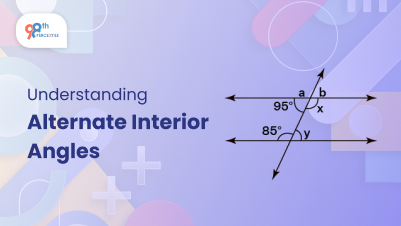Alternate interior angles are a pair of angles that are on opposite sides of the transversal and inside the parallel lines. In geometry, the theorem states that when the lines are parallel, the other interior angles are equal. In alternate interior angles, the interior angles or exterior angles are congruent. The alternate angles are equal because they are formed by the same pair of intersecting lines.
This article particularly highlights all the main features of alternate interior angles and its theorem statement. The proof-based alternate interior angles, co-interior angles, and examples are going to be discussed below.
Access Your FREE Math Worksheets Instantly!
Definition of Alternate Interior Angles
The angles are formed inside the two parallel lines and intersected by a transversal are all equal to its other alternate pairs.

The converse of this theorem is true; however, two lines are cut by the transversal, so the other alternate interior angles appear congruent. On the other hand, alternate exterior angles are in the outside position of the two lines being intersected by the transversal.
Properties Of Alternate Interior Angles
The properties of Alternate interior angles are mentioned below-
- Alternate interior angles are congruent
- The sum of angles is always 180°
- In non-parallel lines, alternate interior angles don’t have certain properties.
Theorem and proof
If two parallel lines are cut by transversal, each pair of alternate interior angles would be equal.
Proof
- Suppose two parallel lines and the third line cutting across them are called transversal.
- Level angles are when transversal cuts parallel lines.

PQ and RS are two parallel lines, intersected by the transversal XY.
To prove:
∠3= ∠6 and ∠4= ∠5.
Proof:
∠2 = ∠5…… (1) (Corresponding angles)
∠2 = ∠4…… (2) (Vertically opposite angles)
From 1 and 2 we identify ∠4= ∠5 (Alternate interior angles)
Another way,
∠3= ∠6
Hence proved
Co-interior angles
In co-interior angles, two angles are on the same side of the transversal. Co-interior angles’ sum up is 180°. It means two interior angles are on a similar side and transversal is supplementary.

Angles g+h= 180°
Co- Co-interior angles are resembling like C and the angles are not equal. They have different vertices and they lie between two lines. The sum of co-interior angles formed is always added up to each other. 180 degrees. The Co-interior angles are also known as consecutive interior angles. These angles lie between two lines and contain different vertices. Co-interior angles are not adjacent and the sum of a parallelogram is always supplementary.
To sum up, Alternative interior angles in geometry are only considered when a transversal passes through two lines. It has various properties that depend on different situations. The sum of the alternative interior angles will remain the same, that is 180°. Alternate interior angles are supplementary and not complementary. In the case of non-parallel alternate interior angles do not follow any particular properties.
To know more please visit our site www.98thpercentile.com or you can try 1-week free classes for Math.
FAQs (Frequently Asked Questions)
Q.1: What is the formula for interior angles?
Ans: The sum of the measures of interior angles of the convex polygon of n sides (n-20) 180° or (2n-4) right angles.
Q.2: Are alternate interior angles congruent?
Ans: Yes, alternate interior angles are congruent, and the sum of the angles is 180°.
Q.3: How do you solve an alternative interior angle?
Ans: First use the fact that angles are equal when cut across two parallel lines.
Q4: Are co-interior angles supplementary?
Ans: Yes, co-interior angles are supplementary.
Q.5: What is a linear pair?
Ans: It is a pair of adjacent, supplementary angles.
Book FREE Math Trial Classes Now!

 Students/Staff
Students/Staff Parents
Parents ElevatEd
ElevatEd



-Nov-18-2025-03-57-47-3267-AM.png?width=360&length=360&name=401x226%20(6)-Nov-18-2025-03-57-47-3267-AM.png)



-Jul-22-2025-03-16-52-8797-AM.png?width=360&length=360&name=401x226%20(6)-Jul-22-2025-03-16-52-8797-AM.png)






